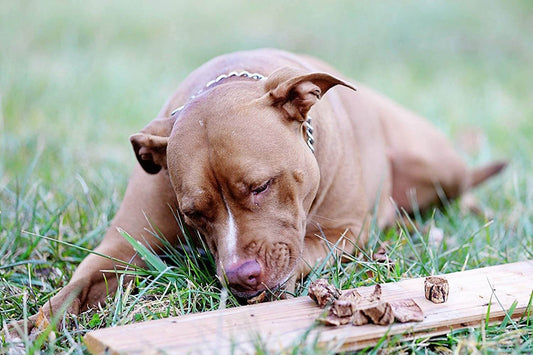How Much Fat Is in Beef Trachea for Dogs? It's Complicated!
Dawn Miller Sep 26, 20245 Minute ReadHow much fat is in beef trachea for dogs? Let me tell you a story. The other night, I was binge-streaming a romantic period drama while my partner was out of town on business.
As I snuggled up with a big bowl of popcorn with my favorite toppings—extra virgin olive oil and a light dusting of cajun seasoning, I realized that I've never particularly tried to eat low-fat (or at least not since the early 2000s when that was the big thing). And yet, I'm very conscious of my dogs' fat intake. Dogs are more sensitive to high fat intake—especially the wrong fats. So, the amount of fat in the beef trachea was definitely something I needed to find out as a responsible dog guardian.
And some of you have told me that your sweet fur baby's dog doctor has told you to cut the fat from your dog's diet—including dog bones. Is beef trachea safe for dogs on a low-fat diet?
Here's what I learned when I explored the answer to these questions.
How Much Fat Is in Beef Trachea for Dogs?
Not much at all! Beef trachea for dogs contains roughly 10-15% fat, making it a relatively lean treat. The amount of fat is further reduced by choosing beef trachea from grass-fed beef herds. Pasture-raised herds have naturally lower levels of fat, particularly saturated fat. At the same time, grass-fed animals have higher rates of omega 3, the healthy fats I want to be in my dog treats.
This is equivalent to buying some 90/10 lean ground beef, so yes, this is pretty lean. I don't know about you, but when I buy beef that lean, I have to add a little fat to make it cook up right.
A Look at the Beef Trachea Fat Profile (Source: USDA)
Now, I couldn't find the precise nutritional information for the trachea since it's not commonly found on American dinner plates. But the USDA does have nutrition information for "beef variety meat." That's code for meaty parts of animals we don't eat in the US most of the time—primarily organ meats. So, it includes beef trachea, which is mostly muscle and nutrient-rich cartilage. This also comes from nutrition information for conventionally raised cattle, which have higher saturated fat than grass-fed. But this is a good reference point nonetheless.
So, 100 grams of "variety meats" contain only 3.7 grams of total fat. For us Americans who don't think in metric, 100 grams is about 3.5 oz of meat, so a small steak or a Quarter Pounder from McDonald's. So, that's a lot more than my dogs are going to eat in a sitting. Even my lab mix Bruno would struggle to eat that much beef trachea treat. It takes a while to chew.
Of that 3.7 grams, 1.27 grams are saturated. So, a little less than half.
Almost 1 gram is the healthier monounsaturated fat.
And .51 grams are polyunsaturated fats. Polyunsaturated fats include omega 3, 6, and 9. Now, conventionally raised beef is not very high in omega 3. But I source my beef trachea from grass-fed USA-based cattle ranches, to get this added benefit.
Both omega-3 and conjugated linoleic acid (a type of omega-6 fat) are considered anti-inflammatory and health-promoting.
How Does this Compare to Marrow Bones?
Bone marrow has significantly more fat, but the rule about the grass-fed option improving the fat profile is true here, too.
According to the USDA, 100 grams of grass-fed bone marrow—again about the size of a small steak—contains 19.5 grams of fat, but only 8 is saturated. And it comes with a whopping 30 grams of protein.
Can Dogs on a Low-Fat Diet Have Beef Trachea?
This means that if your dog's vet has said that your dog needs to reduce fat intake, the beef trachea is a smart food swap with 70% less fat than bone marrow. But, please speak with your family vet first and do not take the word of a person on the Internet.
You can find the grass-fed beef trachea I get for my pack here.
Is Beef Trachea Good for Dogs?
It's high in protein (particularly collagen) and loaded with other nutritional benefits, like glucosamine and chondroitin, which support joint health. This is great news for older dogs, who need that extra support to keep their mobility up. Low fat, high protein, and joint-friendly? Sign me up!
When it comes to trachea dog chews, this treat is not only low in fat but also offers excellent digestibility and dental health benefits. As my dogs chew on their trachea treats, the texture helps scrape away plaque, which makes it a great natural option for keeping their teeth clean. Plus, since it's a single-ingredient chew, it's free from unnecessary additives or fillers—just pure, natural goodness!
My 3 dogs love their dog bones, but some nights we take it easy and opt for trachea chews instead. I like variety in my diet, and my dogs seem to agree. The other night was definitely a beef trachea kind of night. We also like the recipes in my dog bone filling recipe guide. It's free for you.
Risk of Fat in a Dog's Diet
Hey. I'm the girl who ate a strict keto diet for almost a year, twice. So, you know I'm not too worried about the impact of a high-fat diet on humans when I choose healthier fats—most of the time. But dog physiology is different. Despite what you might think, dogs in the wild don't typically eat a high-fat diet. Plus, those ancestral wolves actually hunted their own food, so they were a lot more active.
While fats are essential for your dog's overall health, it's important not to overdo it. Too much fat can lead to obesity, pancreatitis, kidney problems, and other health issues. Dogs need fats to support their skin, coat, and energy levels, but high-fat diets can overwhelm their system, especially if they're not very active.
This is where beef trachea chews take the cake. They're low fat compared to other dog treats, including the marrow bones we love so much in this house. So I can give them to my dogs more often without worrying about excessive fat in their diet. But I always ensure treats, including dog bones and dog chews, complement a balanced diet and don't exceed the recommended daily caloric intake. Treats should be no more than 10% of a dog's diet, according to the American Kennel Club.
If your dog is prone to weight gain or has a sensitive digestive system, choosing low-fat options like beef trachea will help prevent long-term issues while still keeping them happy and healthy.
How Much Fat in Beef Trachea Chews?
Now you know. It's not a lot. And over half of it is healthy fat if you choose grass-fed trachea chews. I keep the trachea on my pack's chew time rotation for variety and those added joint health benefits. This is a dog treat I can feel good about giving my 3 dogs.
Available On:
Disclosure: This article may contain affiliate links, which means we may earn a small commission if you make a purchase through these links—at no extra cost to you. We only recommend products we trust and believe will benefit you and your K9.






